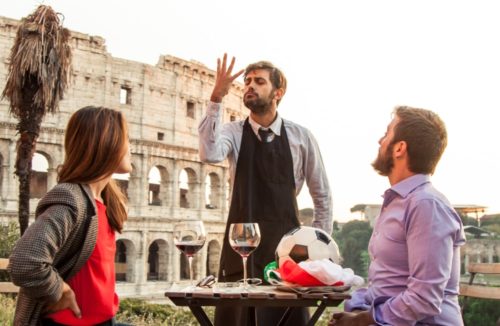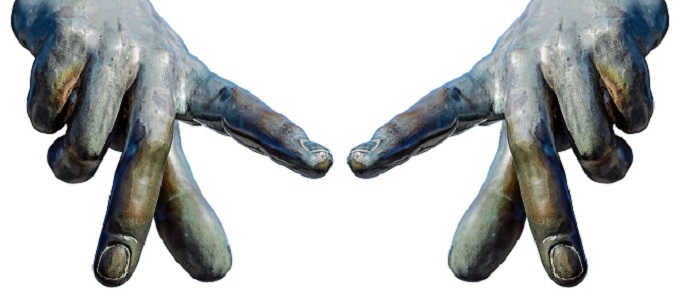Whether born of the necessity to persuade crowds in Ancient Rome, or to be able to understand one another during times of foreign occupation–or even to compete for attention in a densely populated city– the bottom line is indisputable: Italians have been using gestures to communicate for centuries. And as far as I know, they have no plans to stop; grazie al cielo!

One of the most brilliant communicators in all of world history was Marcus Tullius Cicero (106 BC-43 BC). A lawyer, philosopher, statesman, literary genius, and unquestionably one of the most eloquent orators of the Roman Republic, Cicero was sharp, knowledgeable, and verbally persuasive. He also believed that in order to deliver a speech of excellent quality, the message should be accompanied by “movement of the body”, using “gestures, facial expression, and varying the inflection of the voice.” Some likened this great orator to a theatrical performer—only even more captivating.
Researchers have found that gesturing and verbal speech are dynamically intertwined. In ancient times, orators who received Roman rhetorical training were not only made to practice composition and writing style, but they also had to practice the delivery of the speech. Gesticulation was a crucial part of making that speech come to life. Moving the body from head to toe helped to convey emotion, passion, and captivate the attention of a crowd whom the speaker wished to move and persuade.
Marcus Fabius Quintilianus, born in Spain around 35AD, was considered the first public professor of rhetoric (persuasive speech), and authored 12 volumes (Instituto Oratorio) on the education of an orator. He described in great detail every nuance that a public speaker should be concerned about. Examples included wearing the proper toga, memorizing one’s written text, enunciating clearly, and practicing whole-body delivery, including posture, hand and finger gestures, and learning which facial movements would help or damage the impact of the performance (i.e., one should never make movements with the nose while speaking).
How many times have we seen someone—in person or on TV—flail their arms wildly and talk in dummied down English when referring to Italians? “Eh”, they might say, “I’ma Eye-talian. I talk-a with-a my hands.” Well, allow me to point out that the definition of “ignorant” is “lacking knowledge or awareness; uneducated, or unsophisticated”. Check all of the above with respect to those who promulgate these idiotic stereotypes. In the words of Quintilianus: That laughter costs too much which is purchased by the sacrifice of decency.
It’s not that Italians don’t talk with their hands; in fact, they produce a lot of non-verbal communication throughout the day—approximately 250 such daily gestures according to Italian communications expert Dr. Isabella Poggi. But what eludes the ridiculers, is that Italian gesticulation is a sophisticated, culturally rich tradition, created to enhance communication, and is deeply rooted in the history of Italy and its people. Neapolitan-born archeologist Andrea de Jorio (1769-1851) wrote an entire volume on the science of bodily expression, and the connection between contemporary gestures observed on the streets of Naples, and similar gestures uncovered by ancient frescoes and the excavations of Pompeii and Herculaneum. Italian body language is not a meaningless, random flailing of limbs and facial expressions; but rather a complex and refined form of nonverbal communication, for which Italians should be lauded rather than ridiculed.

Studies have found that even Italian children from a very young age, display skillful gesturing likely from being immersed in such a gesture-rich culture. In fact, because of their tendency to include nonverbal communication skills when first learning to talk, Italian children were found to initially have smaller spoken vocabularies than American children of the same age. Those differences, however, quickly disappeared as the children got a bit older. Professor Poggi describes the lexicon of Italian gestures as comparable to the breadth and sophistication of sign language for the deaf. She believes gesturing first became popular in the busy Southern Italian cities as a result of competition, or a way to stand out from the crowd.
Research confirms that communicative symbolic gestures—excluding pantomiming (like making the motion of playing a musical instrument, eating, etc.) –are culture-specific. When researchers compiled a database of over 200 videoclips of an actress performing either pantomimes or emblems (conventional gestures, such as a thumbs-up, waving goodbye, etc) and showed them to both Italian and American participants, agreement between both groups on what the gestures meant was significantly higher for pantomiming actions, but there was a lower agreement between the two groups when interpreting emblematic (cultural-specific) gestures.
 Luigi Barzini, renowned Italian journalist, and best-selling author, believed that Italians use gestures “more abundantly, efficiently, and imaginatively than any other people.” They gesticulate when too distant to hear each other’s words; when it is not polite to express something in words; or as a time-consuming technique, such as when a motorist doesn’t want to slow down to shout insults to another motorist, so instead might simply extend one hand in the direction of the other and fold all fingers except forefinger and little finger, making the shape of the infamous “mano cornuta”, or horned hand . Contrary to the negative stereotype of overly exaggerated contortions of arms hands and fingers, Barzini describes the best Sicilian gestures as being “economical” and so subtle as to be almost imperceptible.
Luigi Barzini, renowned Italian journalist, and best-selling author, believed that Italians use gestures “more abundantly, efficiently, and imaginatively than any other people.” They gesticulate when too distant to hear each other’s words; when it is not polite to express something in words; or as a time-consuming technique, such as when a motorist doesn’t want to slow down to shout insults to another motorist, so instead might simply extend one hand in the direction of the other and fold all fingers except forefinger and little finger, making the shape of the infamous “mano cornuta”, or horned hand . Contrary to the negative stereotype of overly exaggerated contortions of arms hands and fingers, Barzini describes the best Sicilian gestures as being “economical” and so subtle as to be almost imperceptible.
Here are some common Italian gestures and their meanings:
- A slowly raised chin = “I don’t know” (or maybe I know and don’t want to tell you)
- Extended fingers of one hand moving slowly back and forth under raised chin = “I couldn’t care less”
- Lifting of a single eyebrow = “I’m ready to take what decisions are necessary.
- Slow closing of both eyes=resignation or acceptance of an unpleasant duty
- L’ombrello (Bent arm with fist; the other hand slapping the bicep of the bent arm) =a rude way to say go to..(quel paese), or something even more vulgar
- L’occhio (slightly pulling down the bottom eyelid with your index finger) = “Watch out”
- Index finger twisting into a cheek = delicious
- Palm facing up, fingers and thumb pinched together, rocking =What do you want; or Who are you?
When Sicilian actor, director (La Voce Del Corpo) and author Luca Vullo first moved to London and didn’t speak a word English, he used the “transcultural language” of Sicilian gestures to make himself understood. The response was overwhelmingly positive, and he now continues to spread the word about the richness and brilliance of the Italian gestural lexicon across the globe and in the fields of education and business. Italians have made many contributions to the world throughout history. Now, thanks to the efforts of Dr. Vullo, the masterful art of Italian body language communication is helping people better understand each other, no matter what their background, culture, or mother tongue.
Ultimately, the extensive range and complexity of Italian hand gestures can serve as an essential form of communication that opens doors of interpersonal understanding. It is yet another important Italian contribution to Humanity, and an additional reason to be rightfully in awe of our beautiful Italian heritage.
References/For Further Reading
Agostini, Beatrice; Papeo, Liuba; Galusca, Cristina-Ioana; & Lingnau, Angelika (2018). A norming study of high-quality video clips of pantomimes, emblems, and meaningless gestures. Behavior Research Methods, v51,pp 2817-2826.
Barzini, Luigi (1964). The Italians. New York: Simon & Schuster
Cravotta, A., Busa’, M.G., & Prieto, P. (2019). Effects of encouraging the use of gestures on speech. Journal of Speech, Language, and Hearing Research, vol 62, pp 3204-3219
de Jorio, Andrea (translator Adam Kendon, 2000) Gesture in Naples and Gesture in Classical Antiquity: A Translation of LA Mimica Degli Antichi Investigata Nel Gestire Napoletano, Gestural Expression … Neapolitan gesturing (Advances in Semiotics). Indiana University Press.
Fritz Graf (1991) Gestures and Conventions: The Gestures of Roman Actors and Orators. Polity Press.
Iverson, J.M; Capirci, O.; Volterra, V.; & Goldin-Meadow, S. (2008). Learning to talk in a gesture-rich world: early communication in Italian vs. American children. First Language, vol 28(2):164-181
Marcus Tullius Cicero (James M May translation, 2001) Cicero: On the Ideal Orator. Oxford University Press
Luca Vullo Ted Talk: Come Parlare Senza Parlare https://www.youtube.com/watch?v=nqkxiYRTmP8
A Crash Course in Italian Hand Gestures: https://www.theguardian.com/world/shortcuts/2013/jul/02/how-speak-italian-with-hand-gestures
The Fine Art of Italian Hand Gestures: https://www.italianlanguagecentre.org/the-fine-art-of-italian-hand-gestures/







